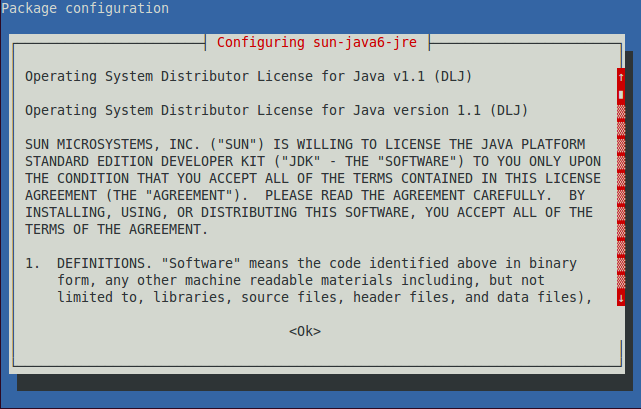Crossfire Map Editor Installation - Ubuntu Linux
How to Install Sun Java Runtime Environment v1.6.0 under Ubuntu Linux
-
The first step is to enable the multiverse repository, as described at: https://help.ubuntu.com/community/Repositories/CommandLine
-
Launch or open a Terminal Window (Applications -> Accessories -> Terminal)
-
You will then want to run this command:
sudo apt-get update
-
Now you will want to install the following packages, sun-java6-jre and sun-java6-fonts, with this command:
sudo apt-get install sun-java6-jre sun-java6-fonts
-
Once the download is finished and the packages begins the installation, you’ll see a screen that contains the Sun Operating System Distributor License for Java; hit Enter to continue

-
Next you will see a dialog that asks you if you agree with the DLJ license terms; Select Yes, and hit Enter

-
The JRE will finish installing
- To check that the JRE is properly installed, run the following command in the Terminal Window
java -version
You should see output similar to this:
$ java -version java version "1.6.0_20" Java(TM) SE Runtime Environment (build 1.6.0_20-b02) Java HotSpot(TM) 64-Bit Server VM (build 16.3-b01, mixed mode)
Launching the Editor
-
Download the Crossfire Map Editor
-
Save the editor (it's the .jar file) in an easy to access location (do not uncompress the file, leave it as a .jar file)
- Launch the editor using the following command:
java -jar CrossfireEditor.jar
If you have enough memory, it is recommended to run the editor with a higher maximum memory size, like 128 Mb:
java -jar -Xmx128m CrossfireEditor.jar
(Note that in this way, the editor won't *always* use 128 Mb. It will only use that much when it is required.)
For larger machines, explicitely requesting a client type VM can significantly speedup the map editor, so consider using -client
java -jar -client CrossfireEditor.jar
Special Instructions
NOTE: If you recently upgraded your Java JRE or having problems launching the editor, or would like to specify a particular version of Java, run this command:
update-alternatives --config java
Follow the instructions that appear:
NOTE: actual output, contents and options will vary, you'll want to use: /usr/lib/jvm/java-6-sun/jre/bin/java
There are 6 alternatives which provide `java'.
Selection Alternative
-----------------------------------------------
1 /usr/lib/j2re1.4-sun/bin/java
* 2 /usr/lib/jvm/java-1.5.0-sun/jre/bin/java
3 /usr/bin/gij-wrapper-4.0
+ 4 /usr/lib/jvm/java-gcj/jre/bin/java
5 /usr/bin/gij-wrapper-4.1
6 /usr/lib/jvm/java-6-sun/jre/bin/java
Press enter to keep the default[*], or type selection number: 6
Using `/usr/lib/jvm/java-6-sun/jre/bin/java' to provide `java'.
Then try launching the editor again.